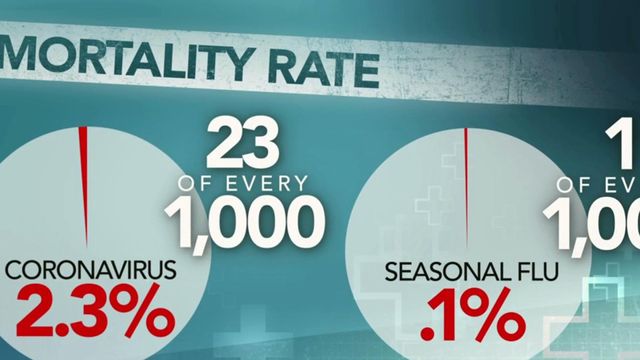How deadly is COVID-19? It's still too early to tell
Scientists can't tell yet how deadly the new virus that's spreading around the globe really is - and deepening the mystery, the fatality rate differs even within China.
Posted — UpdatedAs infections of the virus that causes COVID-19 surge in other countries, even a low fatality rate can add up to lots of victims, and understanding why one place fares better than another becomes critical to unravel.
“You could have bad outcomes with this initially until you really get the hang of how to manage" it, Dr. Bruce Aylward, the World Health Organization envoy who led a team of scientists just back from China, warned Tuesday.
What do we know about the death rate?
In the central China city of Wuhan, where the new coronavirus first exploded, 2 to 4 percent of patients have died, according to the WHO. But in the rest of hard-hit China, the death rate was strikingly lower, 0.7 percent.
Overall, in a study of some 44,000 cases, the mortality rate was about 2.3 percent – 23 deaths for every 1,000 people infected.
There’s nothing different about the virus from one place to another. Instead, the never-before-seen strain of coronavirus struck Wuhan fast – before anyone knew what the illness was – and overwhelmed health facilities. As is usual at the beginning of an outbreak, the first patients were severely ill before they sought care, Aylward said.
By the time people were getting sick in other parts of China, authorities were better able to spot milder cases, meaning there were more known infections for each death counted.
While there are no specific treatments for COVID-19, earlier supportive care may help, too. China went from about 15 days between onset of symptoms and hospitalization early in the outbreak to about three days more recently.
Still, Aylward expressed frustration at people saying: “'Oh, the mortality rate’s not so bad because there’s way more mild cases.' Sorry, the same number of people that were dying still die.”
What about deaths outside of China?
Until the past week, most people diagnosed outside of China had become infected while traveling there.
People who travel generally are healthier and thus may be better able to recover, noted Johns Hopkins University outbreak specialist Lauren Sauer. Countries began screening returning travelers, spotting infections far earlier in places where the medical system wasn’t already strained.
That’s now changing, with clusters of cases in Japan, Italy and Iran, and the death toll outside of China growing.
Aylward cautioned that authorities should be careful of “artificially high” death rates early on: Some of those countries likely are seeing the sickest patients at first and missing milder cases, just like Wuhan did.
How does COVID-19 compare to other diseases?
A cousin of this new virus caused the far deadlier severe acute respiratory syndrome outbreak in 2003, and about 10 percent of SARS patients died.
Flu is a different virus family, and some strains are deadlier than others. On average, the death rate from seasonal flu is about 0.1 percent – about 1 death for every 1,000 people infected – said Dr. Anthony Fauci of the U.S. National Institutes of Health.
That's far lower than what has been calculated so far for COVID-19. But millions of people get the flu every year around the world, leading to an annual death toll in the hundreds of thousands.
Who’s most at risk from COVID-19?
Older people, especially those with chronic illnesses such as heart or lung diseases, are more at risk.
Among younger people, deaths are rarer, Aylward said. But some young deaths have made headlines, such as the 34-year-old doctor in China who was reprimanded by communist authorities for sounding an early alarm about the virus only to later succumb to it.
"Some of the preliminary studies have shown that about 81 percent of people have mild disease when they get the infection," said North Carolina State Health Director Dr. Elizabeth Tilson.
About 13 percent of those infected in China were already severely ill, and while the sickest to start with are at highest risk of death, Aylward said, a fraction of the mildly ill do go on to die – for unknown reasons.
On average, however, the WHO says people with mild cases recover in about two weeks, while those who are sicker can take anywhere from three to six weeks.
The study has some good news for parents.
In the outbreak in China, children and teens were far less likely to become sick from the virus, and the fatality rate was as low for them as the flu.
"When you look at the number of people that get sick, only about 1 percent of them were kids under the age of 10," Tilson said. "So, so far, it seems like kids are doing fine. It's the older people, especially those with underlying chronic conditions that seem to get more in trouble with the infection."
Related Topics
• Credits
Copyright 2024 by WRAL.com and the Associated Press. All rights reserved. This material may not be published, broadcast, rewritten or redistributed.






